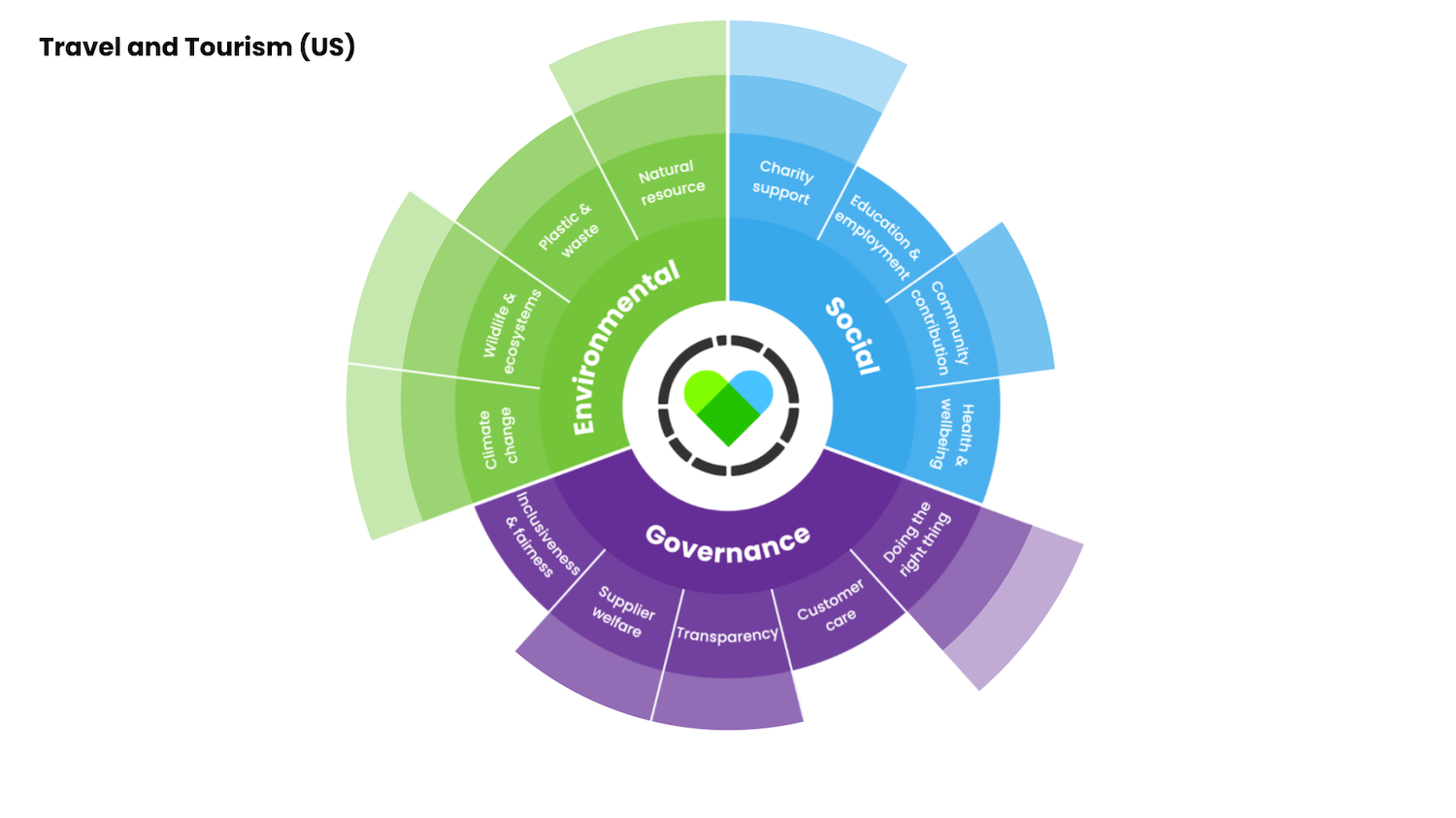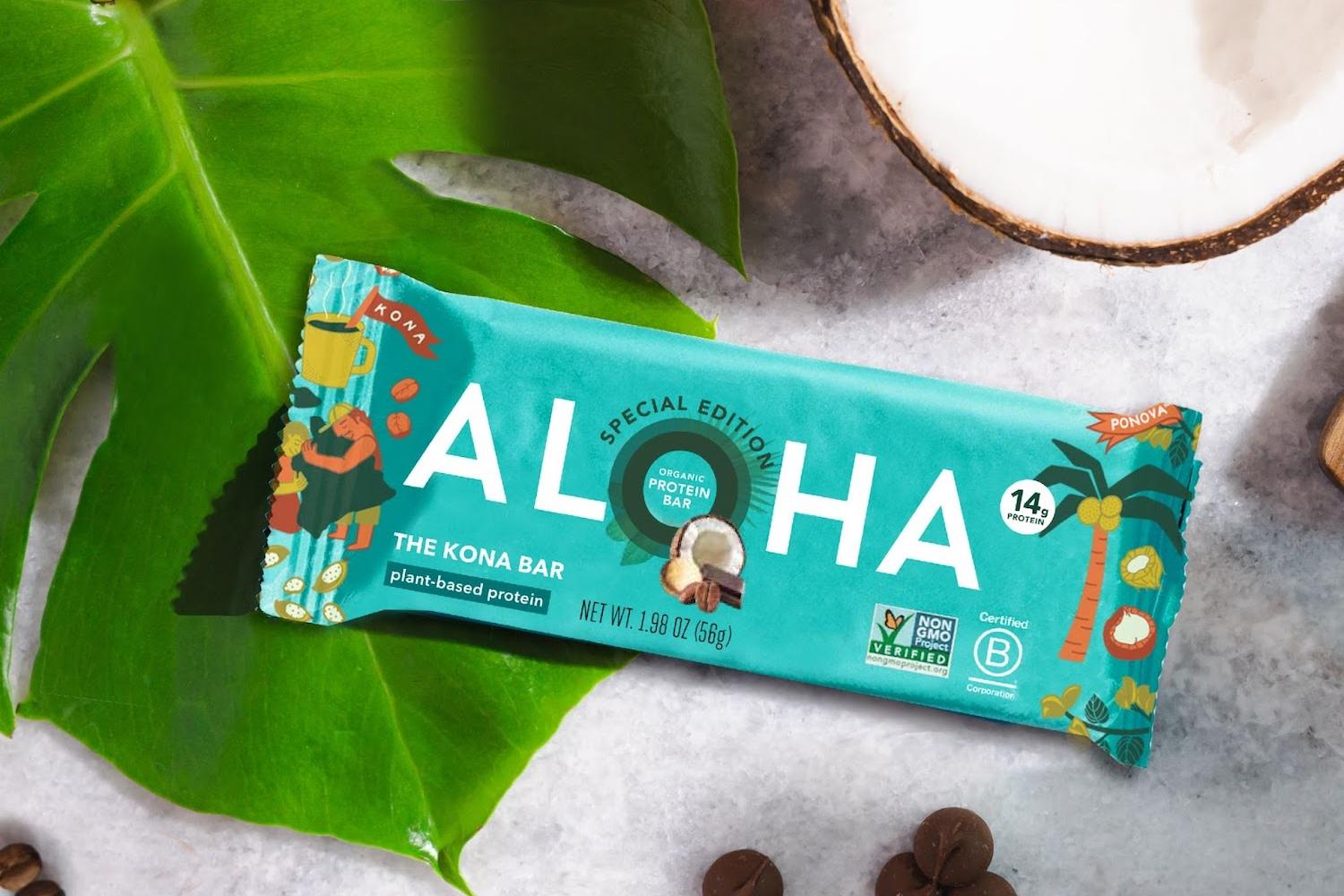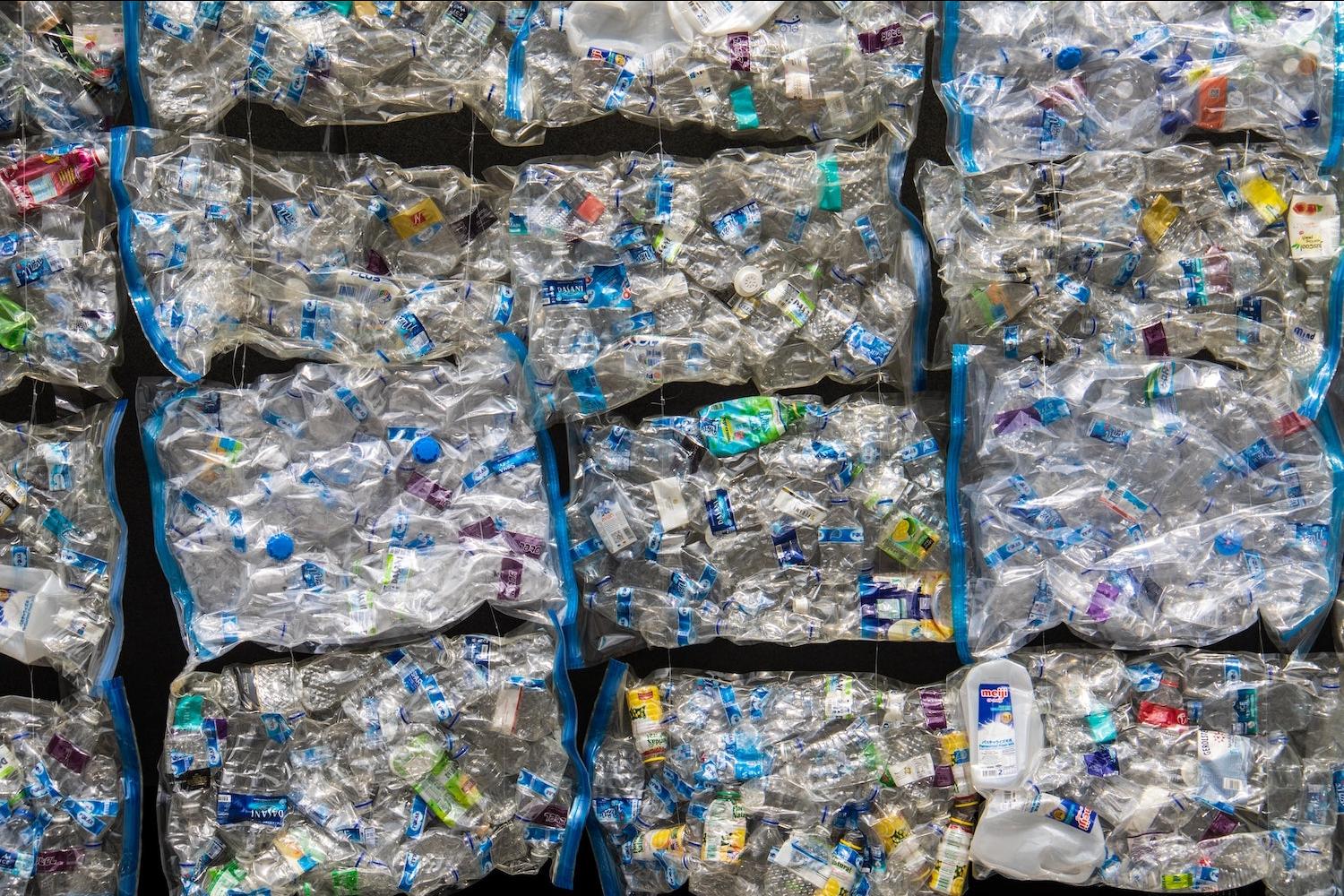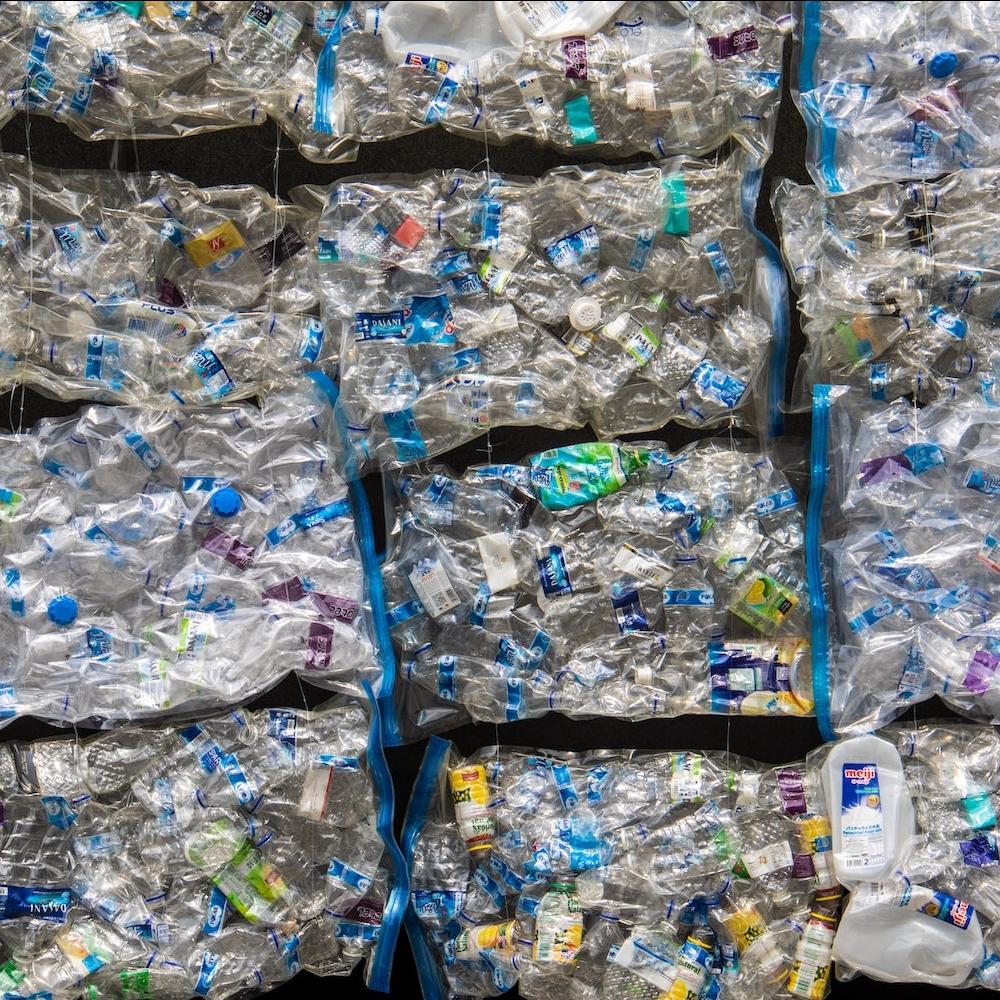What ESG Issues Do Consumers Really Care About?


Research has more than made the case for linking environmental, social and governance (ESG) strategies to corporate profitability. What’s good for people and the planet does, indeed, benefit a company’s bottom line. The trickier part is determining what programs will yield the best results for the investment.
Some ESG pathways are easier to attain and measure direct results, such as cost reductions. But top-line market growth demands a greater understanding of customer wishes and perceptions of a company’s ESG efforts. Those expectations and priorities will differ by industry sector, as well as by geographies, cultures, and demographics like age and gender.
While studies and reports can point companies in the right direction with top-level overviews of trends and industry insights, real-time survey and data collection can dig deeper into what consumers prize in ESG efforts.
Measuring consumer ESG priorities across industries, brands and more
Glow, a research-technology business with offices in North America, Europe and Asia-Pacific, first started tracking what consumers think about ESG issues in relation to purchasing decisions over two years ago. It began with a field of approximately 40 issues that, through multiple research studies across three markets (U.S., U.K. and Australia), were then synthesized into 13 ESG drivers of consumer priorities and perceptions.
The process yielded a diagnostic tool called the Social Responsibility Score (SRS) that not only provides a number to tell a company how it is perceived in its ESG efforts, but also where it stands in its industry and against its competitors and why consumers score it that way.
For example, among food and grocery (F&G) companies in particular, three environmental drivers — reducing emissions, respecting natural resources, and protecting wildlife and ecosystems — ranked highest for importance among consumers, as shown below.

This isn’t to say social drivers like health and well-being aren’t important to F&G customers — they are. But understanding consumers’ top concerns at a given time can help companies prioritize, in terms of both programming and messaging successes. Communicating accomplishments in the areas that matter most to consumers can translate into customer loyalty as well as brand switching.
On the other hand, if a brand and its competitors are all communicating about the same things, it can be harder to stand out. In cases like these, a brand may opt to lean into an area that isn’t as much of a focus for peers and competitors. Or, if it finds it’s under-performing compared to peers on key issues that matter to consumers, it may decide to invest more in those areas and communicate an improvement story.
Listening to consumers via data capture enables this kind of decision-making, helping brands to get the most return on their ESG investments.

Take, for example, these two anonymized F&G competitors from Australia, shown above. Both brands mapped their SRS in relation to the industry benchmark (the green line). Brand A clearly outshines Brand B on virtually all of the 13 drivers. The achievement gap in the areas most important to consumers, such as “reducing emissions” is substantial enough to be a significant opportunity for Brand A to message that success to customers hungry for guidance on where to invest their purchasing power. Meanwhile, Brand B can see where it’s progressing and where further investments can help it improve credibility.
ESG drivers differ across industries
What weighs heaviest on consumers’ minds will vary across industries. For example, Glow found that governance and social drivers are the biggest influences on ESG credentials in the health insurance industry in the U.S., as shown below.

In travel and tourism, on the other hand, U.S. customers view all three divisions of environmental, social and governance factors as important for the sector to address.

In a balanced framework such as the latter, drilling further down into age, gender, geography, and competition among brands is vital to determine the focus for programs and messaging to avoid spreading investment and resources too thin.
Continuing to zero-in on what matters to who
Price and quality are typically the engines powering consumer choices, but business leaders may be surprised at how strong “sustainability” has become as a beacon to consumers looking for safe harbor for their purchasing dollars.
This is especially true in the F&G sector — where 1 in 2 U.S. consumers have switched brands based on sustainability considerations, and 1 in 5 ranked ESG/sustainability as one of the top three drivers for deciding what brands to purchase, according to Glow data.

Diving deeper to look at age segmentation, millennials prized ESG/sustainability even higher, with 1 in 3 such consumers rating it as one of their top three considerations, behind price and quality. Further, 10 percent of millennials rated ESG/sustainability as the top influencer of their purchase decisions, even more than price and quality, Glow found.
These findings demonstrate the importance of ESG initiatives and messaging to any company’s bottom line. To fail in listening and responding to consumers in this regard is to surrender profits and reputation to competitors that are willing to leverage the feedback.
Data and surveys give a brand that feedback continuously since the measurements can be taken over set time periods, in connection with program launches or in tandem with media campaigns.
“The response from people taking these surveys is actually very clear. You can understand what it is that’s driving the consumer response and what’s driving the metric you receive,” said Tim Clover, CEO of Glow. “It allows you to line up the programs you’re running with the different areas and ask, ‘Are these the programs we should be communicating?’ If so, to whom do we communicate and through which media?”
Alignment of ESG programs with consumer expectations, coupled with alignment of messaging to bring about positive public perception of those programs, creates a winning combination for brands.
The tools exist to know what ESG concerns consumers really care about. The decision to use those tools enables business leaders to enhance brand profitability while “doing the right thing.”
This article series is sponsored by Glow and produced by the TriplePundit editorial team.
Image credits: georgerudy/Adobe Stock and Glow
Walgreens Claps Back at Medication Abortion Foes, But Not Really


Walgreens set off a media firestorm last week when the company appeared to knuckle under a Republican-led attack on its sale of the popular abortion medication mifepristone. Walgreens issued a clarification earlier this week, but it may be too little, too late. The legal status of mifepristone is under attack by anti-abortion factions affiliated with religious extremism. Walgreens and other pharmacies will be forced to take a stand on their own principles until the legal clouds part – if they ever do.
The background: The Biden administration pushes back against anti-abortion state laws and braces for an attack on mifepristone
The media storm churned up in the aftermath of a February letter penned by attorneys general from 20 Republican-controlled states — in which they warned both Walgreens Boots Alliance and CVS against selling mifepristone through the U.S. Postal Service.
The letter was intended to thwart a January finding issued by the U.S Department of Justice, which helps to protect access to medication abortion by mail. Specifically, it shields employees of the U.S. Postal Service from criminal charges related to state laws that outlaw or restrict the use of mifepristone.
As an additional protective measure, in January the U.S. Food and Drug Administration also established a new certification process that empowers pharmacies to continue selling mifepristone at their stores and through the mail.
The FDA first approved mifepristone in 2000, and some critics have charged that forcing pharmacies to undergo a new certification process is burdensome considering the drug has established a solid safety track record for more than 20 years. However, the certification process will help provide the Joe Biden administration with legal leverage to challenge a new lawsuit filed against the FDA by Alliance Defending Freedom.
ADF is the same conservative Christian group behind the successful Dobbs v. Jackson challenge to abortion rights in the U.S. Supreme Court. A decision on the FDA case is now in the hands of Matthew Kacsmaryk, a federal judge in Texas appointed by former President Donald Trump. Kacsmaryk is affiliated with a conservative Christian organization and has expressed support for restricting access to both abortion and contraception.
What’s a pharmacy to do?
The Biden administration has signaled that it will appeal if Kacsmaryk decides to strip FDA approval from mifepristone.
In the meantime, Walgreens has apparently begun taking steps to protect itself against legal action in Republican-led states. On Feb. 21, Kansas Attorney General Kris Kobach issued a press statement declaring that Walgreens has agreed “not to mail the medical abortion pill into the state,” in addition to agreeing not to dispense mifepristone at its stores in Kansas.
That press release didn’t seem to create much of a media stir, and the issue seemed to fade from sight by the end of Feburary. However, the media spotlight finally struck home last Friday when CNN reported that Walgreens “will not distribute abortion medication in 20 states, bowing to pressure from anti-abortion lawmakers and lawsuits targeting the legality of medication abortion.”
Numerous other news organizations picked up the story, including National Public Radio. On March 4, NPR reported that “Walgreens won't distribute abortion pills in states where Republican officials have threatened legal action — including some places where abortion is still legal and available.”
In the same story, NPR quotes a March 3 statement it received from Walgreens, in which the company said it is still taking steps to sell mifepristone in “jurisdictions where it is legal and operationally feasible."
Walgreens tries to clear the waters
Walgreens clarified its position in a statement posted on its website on Monday. “We want to be very clear about what our position has always been: Walgreens plans to dispense mifepristone in any jurisdiction where it is legally permissible to do so,” the statement reads. “Once we are certified by the FDA, we will dispense this medication consistent with federal and state laws.”
“Providing legally approved medications to patients is what pharmacies do, and is rooted in our commitment to the communities in which we operate,” the company added.
That position seems reasonable enough for a leading U.S. corporate citizen faced with a legal landscape fraught with landmines. But the company may have waited too long to set the record straight.
California Gov. Gavin Newsom brought further attention to the issue earlier this week. In response to the March 3 CNN report, he posted the following message on his Twitter account on Monday: “California won't be doing business with @walgreens — or any company that cowers to the extremists and puts women's lives at risk. We're done.”
As of this writing, the actual impact on Walgreens operations in California is unclear. By the time Walgreens issued its updated statement on Monday, “a spokesperson for the governor said ‘all relationships’ between Walgreens and the state were now under review but declined to detail how business ties might change,” Reuters reported.
One outcome is perfectly clear, however. The legal cloud over abortion rights is impacting the business of health care in every state, Republican or not. To the extent that business leaders have supported Republican candidates for office, they have only themselves to blame.
Providing financial bandwidth for religious extremism to insert itself into positions of powerful public responsibility was never a good idea to begin with, and the fallout is spreading with every passing election. As the 2024 presidential election cycle gears up, business leaders have an opportunity to help banish governance-by-belief and restore informed, fact-based policymaking to the legislative bodies in all 50 states.
Image credit: Stephanie Rhee and Jennifer Shishmanian via Unsplash
Your Tax Dollars at Work: 3 New Clean Power Resources to Watch


The National Solar Thermal Test Facility operated by the Energy Department’s Sandia National Laboratory in Albuquerque, New Mexico.
Wind turbines and solar panels have finally surged into the mainstream of the U.S. energy profile, but that doesn't mean the renewable energy field has fully matured. Vast new clean power resources are yet to be tapped, and the U.S. Department of Energy is leveraging its financial muscle to lift new, sustainable energy systems from the design table to commercial production.
1. Concentrating solar power plants
Concentrating solar power plants do just what the name implies. Using specialized mirrors, they pull sunlight from a range of inputs and concentrate it on a central point. The result is a powerful blast of heat that can be transferred to a liquid medium, such as molten salt or a specialized oil.
The heated medium can be used to supply clean power for industrial processes that require high temperatures. It can also be sent to a boiler room to produce steam to generate electricity.
Concentrating solar systems are large, complex and expensive compared to conventional arrays of solar panels, but they do have a key advantage. The heated medium acts as a built-in storage reservoir, enabling the solar energy to keep working long after the sun goes down.
These solar-thermal systems are gaining traction as a clean power solution in some parts of the world, but they have been slow to catch on in the U.S. The U.S. Energy Department showcased a group of five concentrating solar projects during the Barack Obama administration, but investor follow-through did not materialize after the White House changed hands.
The apparent lack of private-sector interest did not deter the Energy Department. During former President Donald Trump’s first year in office, the agency launched a $100 million research effort called Gen3 CSP — which aimed to drive down the cost of solar-plus-storage to 5 cents per kilowatt-hour, with facilities in the range of 100 megawatts capable of delivering clean power on a 24/7 basis. At that scale, concentrating solar systems would replace conventional fossil energy power plants and nuclear energy, too.
There are two key, intertwined differences between the Gen3 program and the Obama-era projects. One is the use of ceramic particles instead of molten salt. The ceramic formula can withstand higher temperatures of more than 800 degrees Celsius.
That high temperature calls the second key element into play. The range of 800 degrees Celsius enables the storage medium to power a turbine that runs on a fluid state of carbon dioxide instead of conventional steam. These “supercritical CO2” turbines are much more compact and efficient than conventional turbines, leading to the potential for reducing costs.
Gen3 passed a significant milestone last month when the Energy Department’s Sandia National Laboratory broke ground on the construction of a pilot project at the National Solar Thermal Test Facility in Albuquerque, New Mexico. Researchers in Saudi Arabia and Australia are also contributing to the pilot project, which is on track for completion in 2024.

2. Electrofuels from the sea
Another emerging clean power technology to watch is the area of synthetic liquid fuels. Until recently, synthetic hydrocarbon products were made by liquifying coal, gas or other fossil energy inputs. The next generation of synthetic fuels revolves around electrofuels, which are made from captured carbon and green hydrogen.
Much of the activity in the green hydrogen field is centered on electrolysis systems that push hydrogen gas from water with electricity from wind turbines, solar panels or other renewable resources. Of particular note is the offshore wind industry, which is beginning to adopt green hydrogen systems as a complementary technology that puts wind turbines to use at night and at times when demand for electricity normally drops.
The carbon-capture field is also showing signs of moving out to sea. Conventional carbon-capture systems are designed to process ambient air or industrial gases on land. However, researchers note that seawater is already a carbon-capture medium, holding up to 150 times more carbon than air by volume.
Supported by a $650,000 grant from the Energy Department’s ARPA-E funding office, a research team from the Massachusetts Institute of Technology has proposed an offshore seawater carbon extraction system that could be used to help prevent the over-carbonization of seawater from fish farms and other aquaculture activities. The team also makes a case for attaching the system to desalination facilities, and they anticipate that cargo ships could install the system to offset their carbon emissions.
If the MIT system achieves widespread use, the researchers anticipate it would capture far more carbon than existing markets can absorb. Most of the captured carbon would have to be stored in underground formations, they presume.
However, activity in the green hydrogen field shows no signs of slowing down. That presents an opportunity to use the captured carbon for electrofuel systems, which could be located offshore as well as onshore. Recycled-carbon markets — which utilize captured carbon to create raw materials for new products — are also emerging in the plastics and synthetic fabric industries, among others.
The Energy Department seems determined to ensure the supply of captured carbon is sufficient to feed these growing markets. On Feb. 16, the agency’s ARPA-E energy innovation office announced a new $45 million funding program aimed at supporting the development of a commercial seawater carbon extraction industry.
The U.S. Navy has also been providing financial support in the seawater-to-fuel field. That includes a collaboration with the University of Rochester, the University of Pittsburgh and the company OxEon Energy. In 2020, the team demonstrated a new catalyst to convert captured carbon dioxide to carbon monoxide, a necessary step toward producing liquid fuels from gases. OxEon has also received Energy Department funding to develop its technology.
Additionally, in 2022 the Navy awarded $3 million to the University of South Carolina to work on systems for producing ammonia fuel with hydrogen extracted from seawater.
3. Enhanced geothermal systems
Geothermal resources are the sleeping giant of U.S. clean power production, limited to just a few parts of the country by suitable subsurface opportunities. The Energy Department has been working with academic researchers and industry stakeholders to develop a new approach called enhanced geothermal, which involves engineering human-made reservoirs in subsurface formations.
In February, the agency launched a new $74 million grant program for enhanced geothermal systems aimed at unlocking the potential for at least 90 gigawatts of geothermal energy by 2050 over wide areas of the U.S. In comparison, the nation’s current geothermal capacity rests at only 3.7 gigawatts.
Alongside the rapid increase in geothermal development, the Energy Department is also targeting a game-changing 90 percent drop in costs by 2035. “Investments in [enhanced geothermal systems] can unlock affordable clean energy for over 40 million American homes and exponentially increase opportunities for geothermal heating and cooling solutions nationwide,” according to the agency.
The work in geothermal comes under the DOE's “Energy Earthshots” program, the Joe Biden administration’s signature program for accelerating the clean power transition in tandem with new job creation and more equitable economic development opportunities.
Including the geothermal program, Earthshots has already launched six initiatives that pair private-sector partners with research teams and federal financial resources. The five other programs involve green hydrogen, long-duration energy storage, carbon-negative technologies, floating offshore wind turbines, and new approaches for industrial heat.
Leadership in the Republican Party may continue to rail against “woke capitalism” and advocate for a government “so small you don’t even realize it’s there,” as the Republican National Committee tweeted on March 2. However, that ship has clearly sailed. U.S. businesses and innovators are moving on to create a new energy paradigm with the collective support of U.S. taxpayers, regardless of anything that opportunistic Republican leadership can say or do.
Image credits: Sandia Labs/Flickr and U.S. Department of Energy
How to Grow a Sustainability Pilot Into Reality at Scale


Meta data centers are among the most advanced, energy-efficient in the world. Despite their enormous footprint, however, these structures are designed with the respect of our land, our communities, and our people in mind by incorporating design and construction strategies that conserve energy and water, eliminate waste, and responsibly source materials. The result: Our facilities are LEED Gold certified and supported by 100 percent renewable energy.
To drive innovation and efficiency beyond these high standards, our team has multiple pilot programs in various stages of pursuit and delivery. They vary from experimenting with low-carbon concrete and tracking the circular economy of materials, to testing the feasibility of an all-electric construction vehicle fleet and sourcing alternative fuel sources. Yet they are united by one goal: to create future data centers on the cutting edge of performance and sustainability.
A successful pilot means not only securing buy-in from internal stakeholders, along with funding and manpower, but also mapping a path to applicability and scalability across the enterprise. When it comes to determining whether a pilot is viable, our team begins with a five-factor framework:
- Impact: What is the impact of this strategy?
- Application: What is the universality of the pilot?
- Engagement: How will we communicate, with various stakeholders, a message that will most resonate?
- Prioritization: Where will this fall in the line of current and future projects/initiatives?
- Funding: What is the cost (money, time, effort, education/training) to implement?
These questions help us shape each pilot and support higher-level focuses, such as reducing Meta’s carbon footprint. When Meta’s Net Zero program was in its infancy, for example, we strategized pilots to test new technologies and approaches to track the impacts of material composition in our mechanical, electrical and plumbing equipment; our facilities’ operational waste; and potential of alternative fuel types.
In 2021, we proposed HVO (hydrogenated vegetable oil) as a carbon-saving alternative to diesel for construction equipment at one of our European facilities. The site had regional availability of the fuel type, plus the application and contractor partner were deemed a good fit. Ultimately, timing and cost made the pilot too challenging to pursue. Fortunately, our team's extensive analysis on HVO provided the solid promise for a future opportunity with a greater understanding of a successful pilot proposal and further refinement of stakeholder engagement, as well as a new Risk Registry tool to identify potential risks in a project that can derail intended outcomes.
Today, those lessons have shaped an exciting pilot to test low-carbon concrete, the primary contributor to emissions from data center construction (and 8 percent of global emissions overall). Our pilot leveraged artificial intelligence (AI) to identify and test low-carbon concrete mixes and, ultimately, resulted in use at scale in our data center in DeKalb, Illinois, in 2022. In a partnership with the University of Illinois at Urbana-Champaign, we utilized AI to find a sustainable concrete mix with 40 percent lower carbon emissions. The team worked closely with our concrete trade partner, Ozinga, on test applications in non-critical areas to meet a combined goal of both low-carbon and long-term strength requirements.
It’s true that the carbon footprint during the data center construction phase can often be overlooked. To offset this, we work with our general contractors to communicate ways to reduce (and eliminate) the barriers to going green on a typical job site. Meta’s general contractors now implement technologies and processes for more efficient builds, linking to carbon reductions with partners and circularity in our materials. At our Altoona, Iowa, site, we are upscaling onsite tracking to include both construction and operational waste (as well as using hybrid-fuel construction equipment). It’s just one combination leading our builds to greater, sustainable impact.
Thanks to our robust and vetted piloting program, along with engaged stakeholders, we are able to build with successful social and environmental impacts while providing opportunities to integrate new technologies and strategies across our portfolio. We minimize risks across our facilities by testing ideas — whether a change in design or construction, or even a process — and gain wider acceptance before rolling it out for wide-scale application.
And thus, our work toward greater performance and sustainability continues to build.
This article series is sponsored by Meta.
Salesforce Boosts Black-Led Nonprofits with Unrestricted Funding


Cloud-based software company Salesforce recently announced $1 million in grants to 10 nonprofits in the United States and Canada. The grants come from the Salesforce Catalyst Fund, which provides critical, unrestricted funding for nonprofits led by underrepresented leaders. The grantees are nonprofits headed by Black leaders who are providing innovative programs to boost educational achievement and increase the chances for career success for young people of color in the United States.
“To improve the futures of our Black youth and close the wealth gap, we need to invest in leaders who are trailblazing solutions in their own communities with flexible capital that enables these leaders to take risks and pilot new ideas,” said Ron C. Smith, vice president of philanthropy for Salesforce, in a public statement.
As income and wealth inequalities have widened, increasing access to capital for nonprofits led by people of color and underrepresented groups is critical to closing the wealth gap, Echoing Green and the Bridgespan Group found in a 2020 report, “Racial Equity and Philanthropy." Black and Latino nonprofit leaders receive only about 4 percent of philanthropic funding in the U.S., though they make up roughly 10 percent of nonprofit leadership nationwide.
This capital gap is even more pronounced when it comes to unrestricted funding that nonprofits can use to support operating costs and innovation. The unrestricted net assets of Black-led organizations are 76 percent smaller than their white-led counterparts, ultimately contributing to the systemic underinvestment in these communities.
“One critical step we can take to help close this gap is to focus unrestricted funding on smaller, younger nonprofits led by people of color,” Smith told TriplePundit. “The Salesforce Catalyst Fund aims to redistribute the flow of capital to empower and catalyze these organizations.”
Catalyst Fund grantees can use the funds at their discretion, as opposed to traditional giving, which often requires nonprofits to demonstrate an intention to do work that aligns with the funders’ priorities. Too often, this creates a power dynamic “where the funders steer the solutions,” Smith said.
“By distributing unrestricted funding, Salesforce lowers administrative burdens on nonprofits leaders who spend a lot of time chasing funding and reporting their progress back to funders,” he continued. “This allows them to focus on what really matters — bringing innovative solutions to communities in need.”
The 10 organizations receiving grants are:
- Black Boys Code
- Center for Black Educator Development
- Empowr
- Graduate! Philadelphia
- Hack The Hood
- HYPE (Hope for Youth, Inc.)
- Nzinga, Black Is Lit
- Tech Spark Canada
- Urban Male Network
- Watts of Power Foundation
“We are honored to partner with these 10 incredible leaders who are driving change in their communities — from recruiting Black educators, to empowering Black youth to pursue careers in tech,” Smith told us.
While the Catalyst Fund provides unrestricted support to nonprofits, they must meet certain criteria to be eligible. First, they must align with the Salesforce Foundation's focus of addressing racial inequities in education, economic opportunity and community resources. They must also be led by people of color or those from underrepresented groups and specifically look to serve underrepresented populations. In the U.S., Salesforce is specifically targeting Black, Latinx and Indigenous leaders. And, as Smith noted, they must be relatively young and small, with less than 10 years in operation and an operating budget of $2 million or less.
“Our students have consistently said, we need Black teachers. And we need to invest in Black leaders who are paving the way so that all Black students can have a high-quality education and a prosperous future,” said Sharif El-Mekki, founder and CEO of the Center for Black Educator Development, in a public statement.
The Salesforce Catalyst Fund was launched in June 2022 to counter systemic racial inequities in philanthropic funding that impede nonprofits led by, and serving, people of color. The grants are intended to empower leaders and organizations closest to the issues by providing unrestricted funding to enhance the development of new solutions and boost their impact.
The grants to these 10 nonprofits are the second round of funding from the Catalyst Fund, which made grants totaling $2 million in 2022 to 20 nonprofits in the U.S., the United Kingdom and Australia.
Image credit: RODNAE Productions/Pexels
Take a Bite Out of Climate Change With Aloha’s New Climate-Resilient Ingredient


You could be doing your small bit for climate resiliency the next time you bite into a protein bar. How? Aloha just launched a special-edition bar that gets part of its flavor and texture from Ponova oil. The Kona Bar is made from the beans of the ultra-regenerative, climate-resilient pongamia tree that grows on the Hawaiian island of O’ahu.
Ponova oil is the brainchild of California-based food and agricultural innovation company Terviva. The Kona Bar marks the first time the oil has been used commercially in a food product. The pongamia tree is a climate-resilient powerhouse, and Terviva believes it has unlocked its potential as an abundant and sustainable food source with multiple applications.
What makes the pongamia tree so special?
Pongamia trees are unsung tropical heroes. They are resilient, contribute to soil health and grow sustainably on degraded farmland, according to Terviva. The trees are also inexpensive and require little maintenance. And they produce a legume related to soybeans and peas that is high in both protein and healthy, mid-oleic vegetable oil. The oil has been used in Ayurvedic medicine, rural industrial applications and as an energy source for thousands of years. But it hasn’t been used in food — until now.
Not only has Aloha stepped up as the first to use the oil in one of its products, but the Hawai'i-based certified B corporation is also donating 10 percent of the proceeds from every Kona bar sold to the nonprofit Kupa, Hawai’i’s leading youth-focused conservation nonprofit.
Scaling up
While Aloha has gotten on the bandwagon first, other commercial uses of the Ponova oil are likely to follow. Terviva is teaming up with food ingredient supplier Ciranda in order to increase commercial supplies of the oil by mid-2023. Danone has put its muscle behind Terviva as well ⸺ the food giant is planning to raise $54 million in equity funding through the partnership.
“Terviva’s pongamia-based food ingredients broaden access to healthy and environmentally sustainable foods that directly combat climate change. With our food ingredients, we can feed the planet and heal it at the same time,” Naveen Sikka, Terviva’s CEO, told Agfundernews in 2021.
Diversify with climate-resilient crops
Researchers are alarmed that individual tree growth is predicted to decline 56 percent to 91 percent, in large part to climate change, according to a 2022 study published in Global Change Biology. Future forests will have smaller trees that soak up less carbon. That means the food and agriculture industry has to get more creative about utilizing species that can withstand the impacts of climate change.
The current food system, which is responsible for a third of global carbon emissions, needs to be reinvented. Climate-resilient products like Ponova oil and first-movers like Aloha will be part of the solution. Consider that 75 percent of the human diet consists of only 12 plants and five animal species, including soy, maize, wheat and beef. With hunger on the rise globally and monocultures causing a health and environmental crisis, that is not a sustainable situation.
The answer — for the planet and people alike — is diversifying food sources. So chew on that the next time you choose your snack bar.
Image courtesy of Aloha
Curbing Plastic Consumption Will Require Drastic Measures — and Business Should Lead the Charge


By 2050, plastic consumption in the world’s top economies could be almost twice what it was in 2019. And it's not even on track to peak this century. That’s according to a new report from Back to Blue, a multi-year joint initiative from the Economist Impact and the Nippon Foundation. Researchers from the initiative say it's possible to avoid an extreme plastic waste crisis through “bold and sweeping reforms" — and they’re urging U.N. countries to enact multiple stringent and binding policy changes.
But while pushback is expected from certain industries, “Peak Plastics: Bending the Consumption Curve” demonstrates that — when it comes to curbing the tide of plastic pollution that is barreling down the pipeline — there is no room for half-measures. Rather, businesses must choose long-term purpose over profit and lead a cultural change away from single-use plastics.
No single policy can do it alone
Back to Blue researchers used modeling to determine the effectiveness of three different policies that are being considered for inclusion in the U.N. Treaty on Plastic Pollution, compared to the business-as-usual scenario that would lead to 451 million metric tons of new plastic consumption per year by 2050. The forthcoming U.N. treaty is the culmination of agreements made in March 2022 that will bind 175 countries to its stipulations. Negotiations are in progress, and policies should be implemented by the end of next year.
Researchers chose the three policies deemed to have the most potential to affect total plastic consumption for modeling: taxes on the production of new plastics, measures for extended producer responsibility, known as “polluter pays," and a ban on single-use plastics. They found that no single policy would be capable of substantially curtailing the problem by itself.
Multiple measures needed to curb avalanche of plastic consumption
Banning single-use plastics proved to be the most beneficial of the three policies. Under that scenario, plastic consumption in 2050 would be roughly 1.5 times what it was in 2019 ⸺ as opposed to the 1.73 times that can be expected if nothing is done. Likewise, if a tax on new plastics were the only strategy implemented, it would still lead to 1.57 times more plastic produced each year by 2050. A “polluter pays” policy would also do little on its own, with consumption increasing 1.66 times.
Put together, implementing all three strategies would lower the increase to 1.25 times 2019 levels. However, the study’s authors doubt that the U.N. treaty will ultimately have the teeth needed to force the trajectory of plastic consumption downward.
"This report confirms that an urgent, global effort is needed to stop the flood of plastic pollution at its source,” David Azoulay, director of environmental health at the Center for International Environmental Law, said in a statement announcing the report. “The entire lifecycle of plastics, from feedstock extraction and production of plastic precursors to disposal, must be addressed by the future, legally binding U.N. treaty to end plastic pollution. The policy levers examined in this report will not be sufficient: bolder action is needed, including globally coordinated tax mechanisms coupled with ambitious caps on virgin plastic production."
Negotiators must maintain 'the highest levels of ambition'
Of course, neither the petrochemical industry nor producers of consumer goods will take such changes lying down. Like all regulations that threaten profits, they will likely fight tooth and nail against any limits that affect their bottom lines.
"Negotiators of the U.N. plastics treaty must maintain the highest levels of ambition possible when entering the next round of negotiations, and industry needs to play a constructive, not obstructive, role in reaching a deal,” Charles Goddard, editorial director of Economist Impact, said in a statement. “So far, commitments by industry, retailers and brands to reduce plastic waste are short on detail and have failed to materialize. We have to slow the soaring production of single-use plastic. Only a bold suite of legally-binding policies will result in plastic consumption peaking by mid-century."
Making room for purpose and creative solutions
The transition away from plastic consumption will be painful at first, but it also presents an opportunity for leadership. Businesses that value purpose and choose to make the most out of coming policy changes could see elevated brand loyalty — especially among Gen Z consumers — as well as increased competitiveness when it comes to securing talent and even potentially higher profits in the long run.
The policy changes that are being considered for the U.N. treaty could also increase the market share of certain industries and products as consumers adjust to a world without plastic take-out containers and bottled water. In fact, while an entire cultural overhaul will be necessary, businesses with a strong sense of purpose can help lead the charge by offering innovative products and strategies to help the planet recover from our plastic addiction. Regardless of how business reacts, the U.N. must move forward with drastic new regulations.
Image credit: Nick Fewings/Unsplash